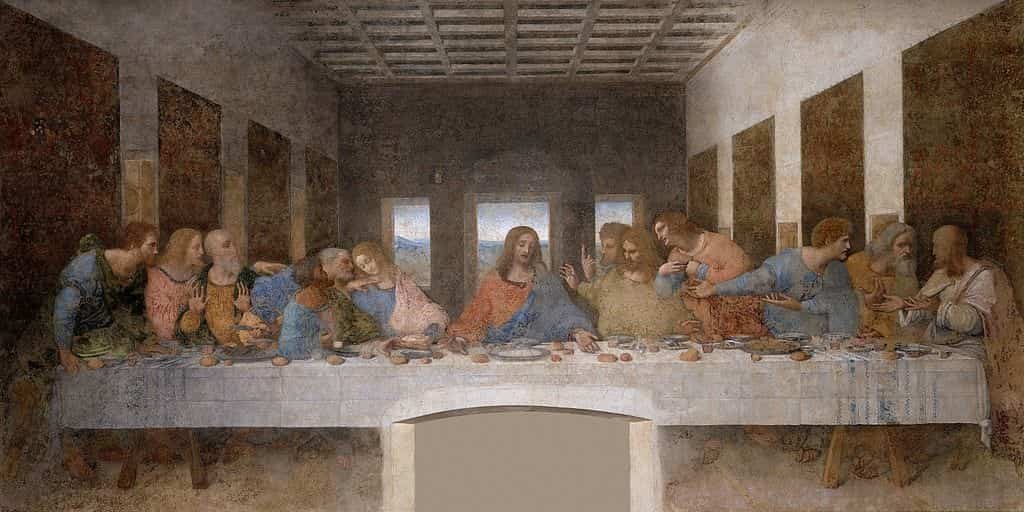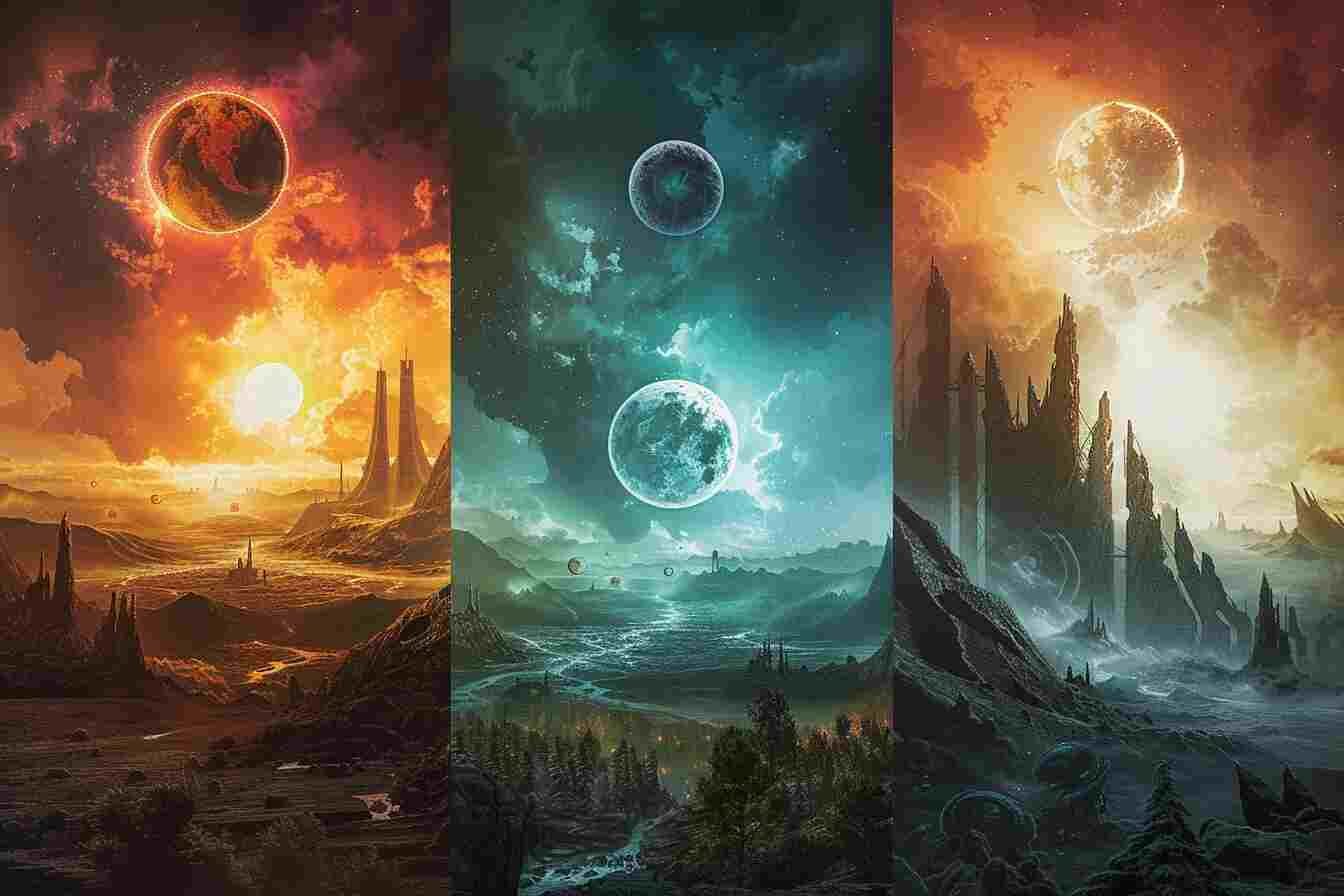The Last Supper Painting
Painted in an era where religious imagery was still the dominant artistic theme, “The Last Supper” depicts the last time Jesus broke bread with his disciples before his crucifixion. The Last Supper painting is actually a large fresco – 4.6 meters (15 ft) high and 8.8 meters (28.9 ft) wide, which makes for an unforgettable sight.
Artist: Leonardo da Vinci
Estimated date: 1495 to 1498
Where to see it: Santa Maria delle Grazie (Church in Milan, Italy). In 1980 the church was declared a World Heritage Site by UNESCO, together with the painting. Leonardo’s Last Supper is located in the original dining room of the former Dominican convent that belongs to the Church of Santa Maria delle Grazie, and more precisely in the refectory of the convent. It is one of the most famous works in the world.
Who is the woman in the painting The Last Supper?
Plautilla Nelli.
Plautilla Nelli is most likely the first woman in history to paint an iconic biblical landscape. In the early 1990s, Jonathan Nelson sought out a lesser-known but historic Florentine painting: “The Last Supper” by Plautilla Nelli, an Italian nun who is said to have taught herself to paint in the 16th century.
What does the painting The Last Supper mean?
The painting represents the scene of the Last Supper of Jesus with his apostles, as recounted in the Gospel of John, 13:21. Leonardo has described the anxiety that occurred among the Twelve Apostles when Jesus announced that one of them would betray him.
Do you know? The painting survived two wartime threats – Napoleon’s troops used the walls of the dining room where it was painted as a target practice. It was also exposed to the air for several years when bombings during World War II destroyed the roof of the Santa Maria delle Grazie Dominican convent in Milan.
Why was the Last Supper was painted?
This painting was commissioned from Leonardo da Vinci by Ludovico le More: the Duke of Milan wanted to embellish the church of Santa Maria delle Grazie to boast of the glory of the Sforza house.
Composition and meaning of The Last Supper Painting
The fresco measures 460 x 880 cm and can be seen in the dining room of the Monastery of Santa Maria Delle Grazie in Milan. The theme was traditional for monasteries’ dining rooms, but Leonardo’s interpretation gave it much greater realism and depth. The lunettes at the top of the fresco are painted with the coat of arms of Sforza . Opposite the fresco is another fresco of the crucifixion, painted by Donato Montorfano . Leonardo began work on the Last Supper in 1495 and completed it in 1498 , although he did not work continuously on the fresco.
The Last Supper records the reactions of the apostles when Jesus said that one of them would betray him. “They looked at each other, unsure who he meant,” writes the evangelist. All twelve apostles have different reactions to this announcement with Da Vinci and are in various stages of anger and shock. From left to right:
Bartholomew, James the Less and Andrew, who form a group, are surprised. Andreas holds both his hands up in the “end!” gesture. For Bartholomew, Leonardo used his own face. In the preliminary study, he accentuated the contours of his face in the red drawing with black ink.
Judas Iscariot, together with Peter and John, forms another group of three. Judas sits in the shadows and looks withdrawn after hearing the revelation of his plan. He holds a small bag of silver pieces, which he was given for betraying Jesus. Peter is holding a knife, pointed in the opposite direction to Jesus, probably anticipating his violent protection of Jesus in Gethsemane. According to the Gospel, he beckons the youngest apostle John to ask Jesus who he means. However, according to some sources, this figure represents Mary Magdalene before, but this contradicts Leonardo’s notes in the manuscript mentioned below, and the iconographic tradition of depictions of the Last Supper.
Thomas, James the Greater and Philip make up the next group of three. Thomas points into the air. Philip points to himself as if to say, “Isn’t it I, Lord?” James the Great (represented by Da Vinci as the brother of Jesus) is surprised and spreads his arms.
Matthew, Judas Taddaeus and Simon the Zealot are the last group of three. Both Matthew and Thaddeus turned towards Simon, probably to get an answer from Simon as to who he might be referring to.
The names used are widely recognized by art historians. In the 18th century a manuscript was found with all the names, before this only Judas, Peter, John and Jesus were identified.
In keeping with other depictions of the Last Supper at the time, Leonardo has adopted the convention of depicting all persons at dinner on one side of the table so that none of those present are looked at from behind. But he deviates markedly from that convention by also placing Judas there in the midst of the other disciples, whereas Judas was usually placed opposite the other apostles, on the other side of the table. Another custom was to provide all disciples, with the exception of Judas, with a halo. Leonardo, however, has opted for a more realistic and dramatic effect by not giving anyone a halo, but depicting Judas leaning back in the shadows.
He also creates a realistic and psychological picture in which he tries to explain why Judas and Jesus take the bread at the same time, just after Jesus has made the prediction of the betrayal. Jesus is shown as if saying so to Thomas and James to his left, who are startled as Jesus points to a piece of bread in front of them. Distracted by the conversation between John and Peter, Judas extends his hand to another piece of bread to which Jesus extends his right hand. All perspective lines and also the incidence of light draw attention to Jesus.
Names of Apostles in The Last Supper Painting
12. Jude
While there is no significant blemish on the good Jude’s record, neither is he owed any accomplishment. A bit like Marcel Gauthier in Broue, he is very forgettable compared to the others. It really is a lost cause …
11. Judas
For obvious reasons, Judas is not popular among apostle reviewers.
10. Bartholomew
He only gave his name to a vague party that no one remembers.
9. James
This is where its merit ends.
8. Matthew
He loses points by writing his name with two “t’s”. Because of him, everyone is mixed up now, when it comes time to write Mathieu … Uh … Matthew.
7. Andrew
He is Peter’s brother. This is where its merit ends.
6. Simon
Rembrandt portrayed him in a 1661 painting, one of his lesser known. Simon’s glory has only dwindled since.
5. Philippe
Before being an apostle of Jesus, Philip was a disciple of his cousin John the Baptist. Today, he looks like he’s an influencer. Well done, Philippe!
4. Thomas
Even though he doubted the authenticity of Jesus’ adventures, his skeptical spirit made him the father of modern science. And we can understand him to have doubted the resurrection of Jesus.
3. Mark
He was the one who wrote the best gospel. With him begins the long tradition of Marc who have a beautiful pen, in particular Marc Lévy and Marc Fisher.
2. Peter
Peter’s name was Simon, but since there was already another Simon in the crew, Jesus suggested another name for him. Jesus said to him: “You will be Peter and on this rock I will build my Church.” We don’t know how successful this pun was in Aramaic, though. Anyway, it was still blood that he agreed to be renamed.
1. John
John was Jesus’ favorite, and not for nothing. Did you know that it was John who managed to get the reservation for the Last Supper? It’s not easy to have a reservation for 13 people who all want to sit on the same side of the table, especially on Maundy Thursday, before the Easter long weekend. We don’t know how he did it, but we would love to have some of his secrets!
The History of the Last Supper Painting
The fresco was ordered by Ludovico Sforza, duke of Milan and patron of Leonardo during his first extended stay in the city. The coat of arms of Sforza appears with the family’s initials at three months above the mural. Leonardo likely began work on the painting in 1495 and, as is his way, worked slowly with long breaks between sessions, until he finished in 1498.
Due to Leonardo’s famed perfection, actual fresco painting is not ideal, as the process requires an artist to apply paint quickly to fresh plaster each day before the plaster dries and binds the pigment to the wall.
Instead, Leonardo tried an experimental technique of using tempera or oil paint on two layers of soil to prepare for drying.
The disrupted process created a pigment (dye) that didn’t stick permanently to the wall and the painting began to peel off within a few years. As it continued to deteriorate, the painting suffered from steam and fumes from the convent kitchen, smoke from the dining room candles and humidity in the location.
Painting restoration
In the following centuries, the painting suffered additional damage. In 1652 a door was cut into the north wall, removing Jesus’ feet and loosening the paint and plaster.
Several restorations followed, with heavy hand retouches and the application of varnishes, glues, solvents, and the like. The painting adds to the irreverence of Napoleon’s invading army using the dining room as a stable. After the flood in the early 19th century, mold growth further damaged the painting.
During World War II the painting suffered its greatest disaster, when Allied bombs caused the roof and one of the walls of the dining room to collapse. The painting survived, but was exposed to the elements for several months before the space was rebuilt.
After centuries of “persecution” of Last Supper frescoes, The Last Supper underwent an extensive and controversial 20-year restoration which was completed in 1999.
Recovery to work in small sections to remove previous minor repaints, dirt and varnish layers while adding cream watercolor to areas that could otherwise be irreversible.
When the restored paintings were revealed, many critics argued that the restorers had removed so many paintings that very little remained of Leonardo’s original work. However, others praised the restoration of details such as the Apostles’ expressions and the food on the table.
How to get to the Church of Santa Maria delle Grazie
The Church of the Last Supper by Leonardo da Vinci occupies a central position and is well connected by transport. The MM1 line ‘Conciliazione’ or MM2 line ‘Cadorna’ metro stops are close to the monument, which is signposted as ‘Cenacolo Vinciano’ when you come to the street. The point of reference is the Corso Magenta street, which leads directly to the Church.
If you leave from Milan Central Station and take the green line (MM2), you will only have five stops to reach the church. From the Dome, it is only a 20 minute walk.
What are the options to see The Last Supper
The means of protection used for the painting and the limited number of places for the visits require good organization when buying tickets to see The Last Supper. It is not enough to go to the ticket office and enter. On the contrary: this modality is very risky.
Here are the different formulas to see The Last Supper:
– Buy the official ticket
– Book a tour with a guide. This formula is interesting for those who have not been able to obtain tickets or who wish to live an intense and deep experience. The guided tour can be done just for The Last Supper or combined with other attractions in Milan.
Sumber bacaan: PinterPandai, Milan Museum, Arts and Culture
Photo credit: Wikimedia Commons



